Hotel And Tourism Industry Assesment Report
VerifiedAdded on 2022/08/18
|16
|3615
|20
AI Summary
need to do third assignment and destination should be Netherlands with current sources not before 2017 and sources should pass crap test
Contribute Materials
Your contribution can guide someone’s learning journey. Share your
documents today.
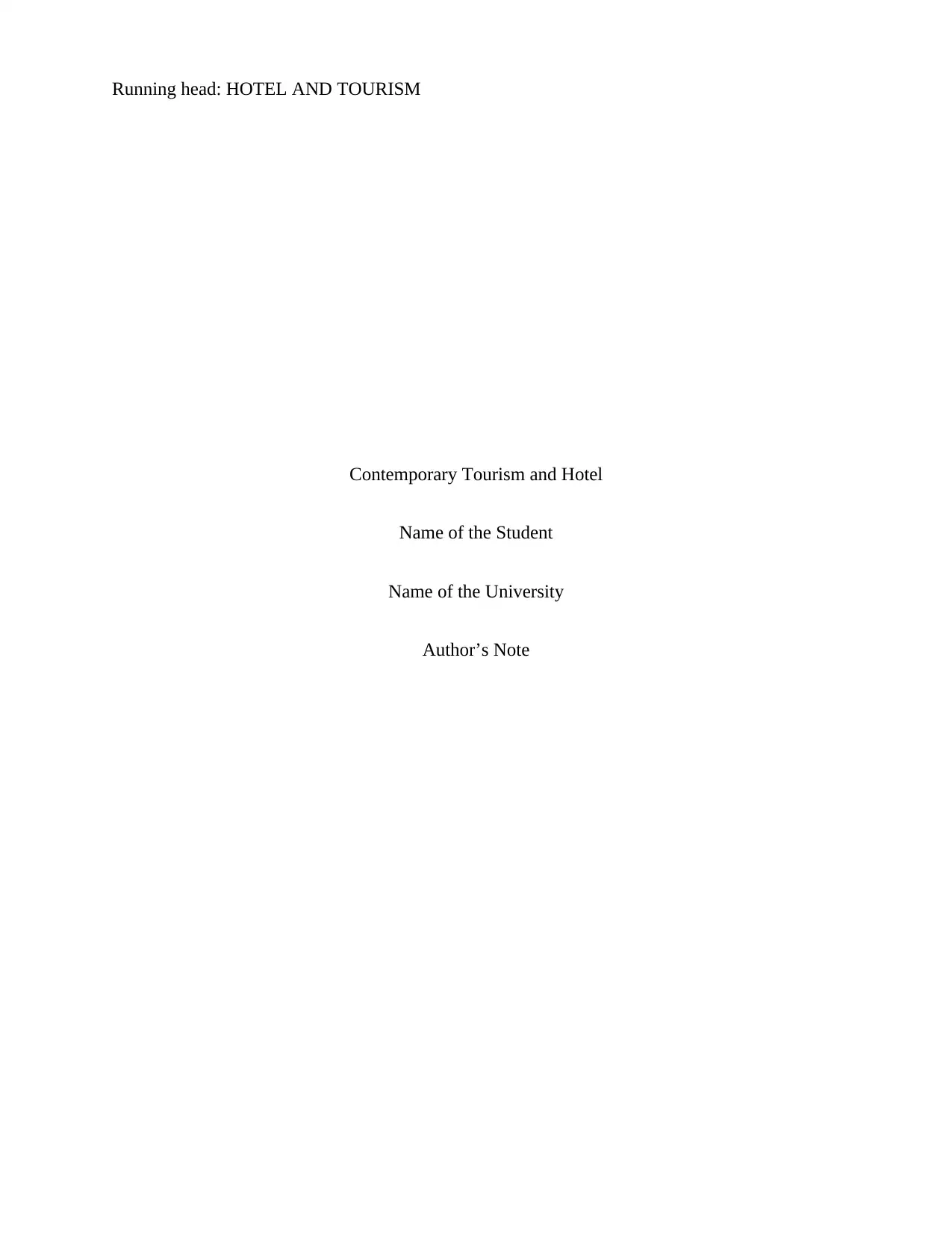
Running head: HOTEL AND TOURISM
Contemporary Tourism and Hotel
Name of the Student
Name of the University
Author’s Note
Contemporary Tourism and Hotel
Name of the Student
Name of the University
Author’s Note
Secure Best Marks with AI Grader
Need help grading? Try our AI Grader for instant feedback on your assignments.
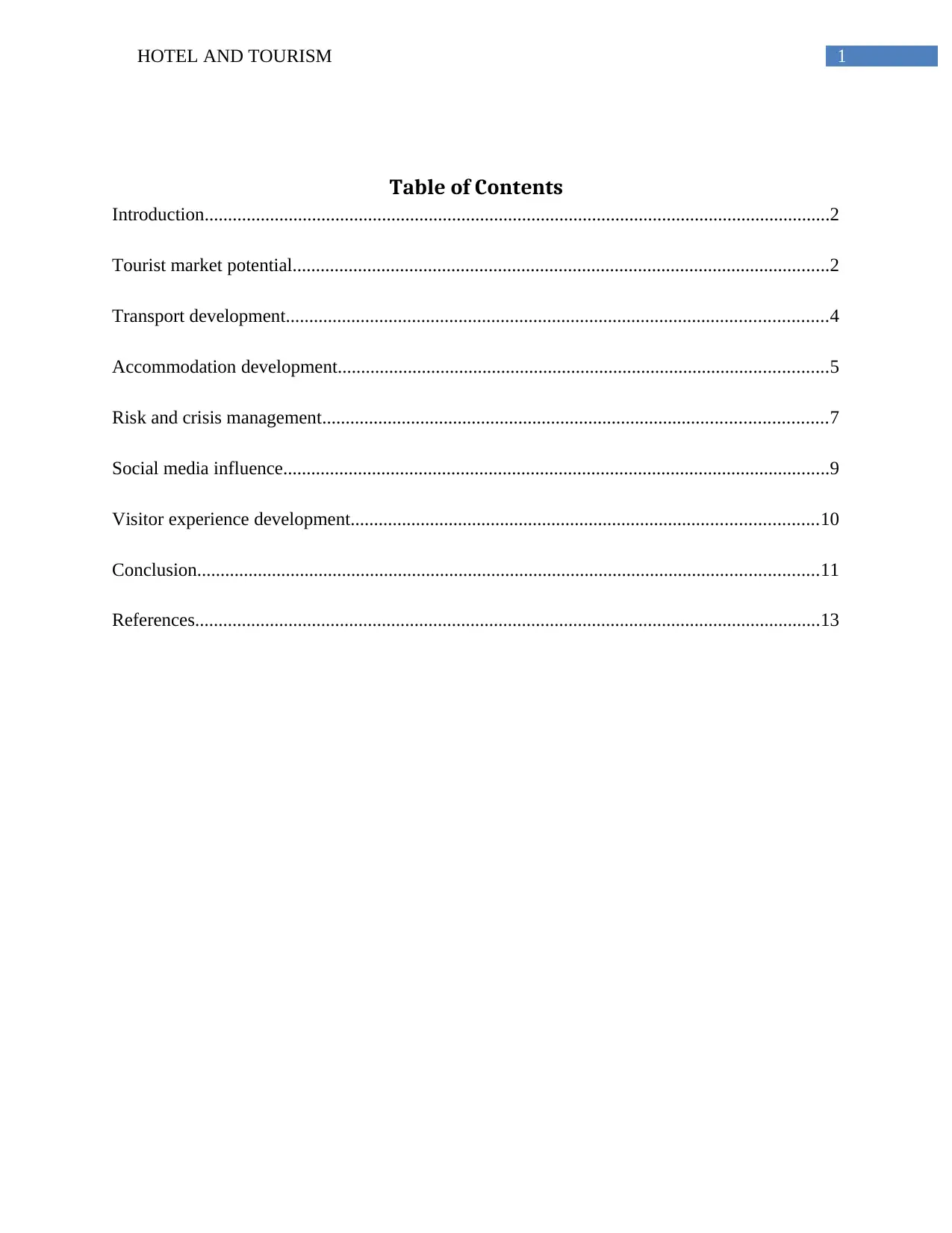
1HOTEL AND TOURISM
Table of Contents
Introduction......................................................................................................................................2
Tourist market potential...................................................................................................................2
Transport development....................................................................................................................4
Accommodation development.........................................................................................................5
Risk and crisis management............................................................................................................7
Social media influence.....................................................................................................................9
Visitor experience development....................................................................................................10
Conclusion.....................................................................................................................................11
References......................................................................................................................................13
Table of Contents
Introduction......................................................................................................................................2
Tourist market potential...................................................................................................................2
Transport development....................................................................................................................4
Accommodation development.........................................................................................................5
Risk and crisis management............................................................................................................7
Social media influence.....................................................................................................................9
Visitor experience development....................................................................................................10
Conclusion.....................................................................................................................................11
References......................................................................................................................................13
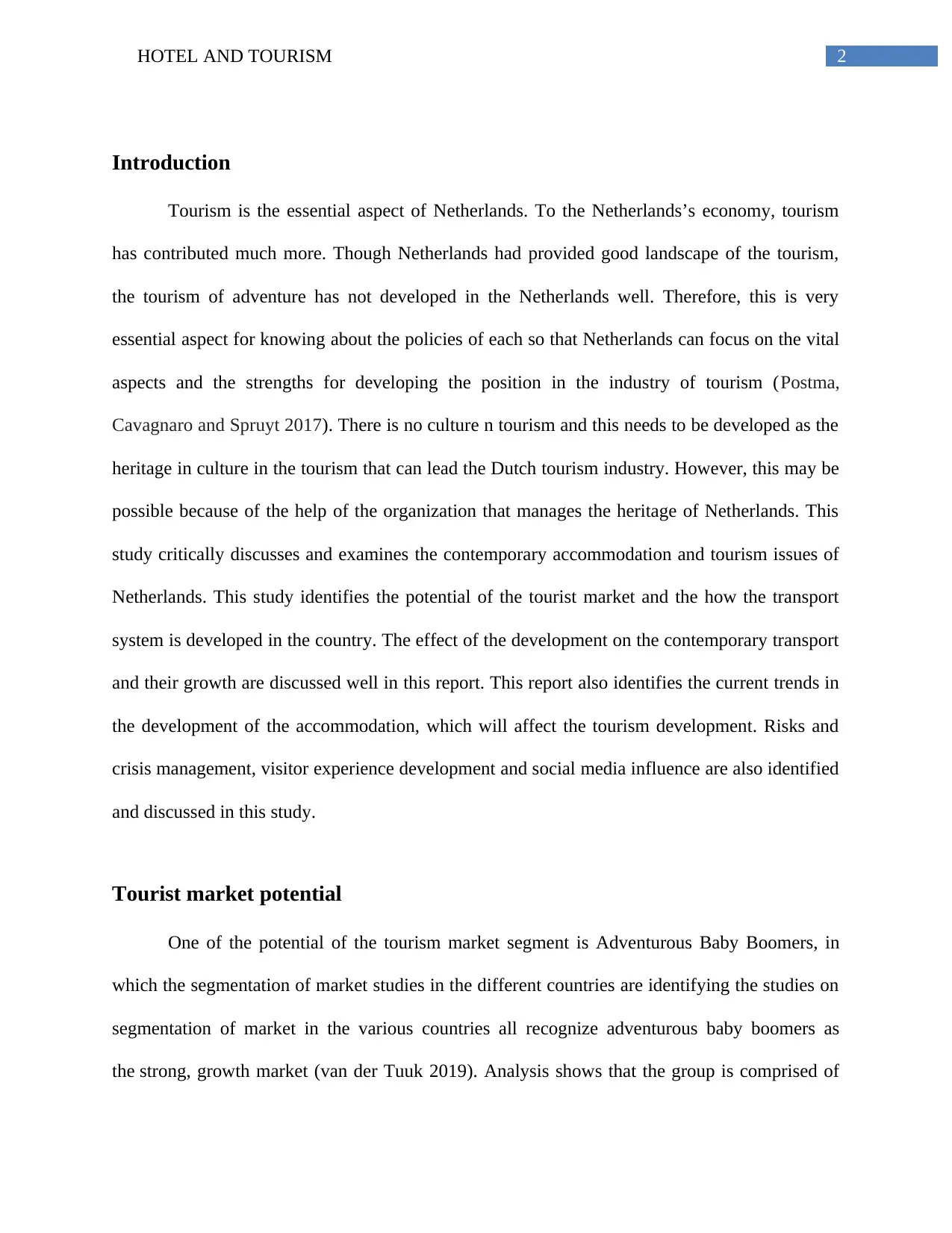
2HOTEL AND TOURISM
Introduction
Tourism is the essential aspect of Netherlands. To the Netherlands’s economy, tourism
has contributed much more. Though Netherlands had provided good landscape of the tourism,
the tourism of adventure has not developed in the Netherlands well. Therefore, this is very
essential aspect for knowing about the policies of each so that Netherlands can focus on the vital
aspects and the strengths for developing the position in the industry of tourism (Postma,
Cavagnaro and Spruyt 2017). There is no culture n tourism and this needs to be developed as the
heritage in culture in the tourism that can lead the Dutch tourism industry. However, this may be
possible because of the help of the organization that manages the heritage of Netherlands. This
study critically discusses and examines the contemporary accommodation and tourism issues of
Netherlands. This study identifies the potential of the tourist market and the how the transport
system is developed in the country. The effect of the development on the contemporary transport
and their growth are discussed well in this report. This report also identifies the current trends in
the development of the accommodation, which will affect the tourism development. Risks and
crisis management, visitor experience development and social media influence are also identified
and discussed in this study.
Tourist market potential
One of the potential of the tourism market segment is Adventurous Baby Boomers, in
which the segmentation of market studies in the different countries are identifying the studies on
segmentation of market in the various countries all recognize adventurous baby boomers as
the strong, growth market (van der Tuuk 2019). Analysis shows that the group is comprised of
Introduction
Tourism is the essential aspect of Netherlands. To the Netherlands’s economy, tourism
has contributed much more. Though Netherlands had provided good landscape of the tourism,
the tourism of adventure has not developed in the Netherlands well. Therefore, this is very
essential aspect for knowing about the policies of each so that Netherlands can focus on the vital
aspects and the strengths for developing the position in the industry of tourism (Postma,
Cavagnaro and Spruyt 2017). There is no culture n tourism and this needs to be developed as the
heritage in culture in the tourism that can lead the Dutch tourism industry. However, this may be
possible because of the help of the organization that manages the heritage of Netherlands. This
study critically discusses and examines the contemporary accommodation and tourism issues of
Netherlands. This study identifies the potential of the tourist market and the how the transport
system is developed in the country. The effect of the development on the contemporary transport
and their growth are discussed well in this report. This report also identifies the current trends in
the development of the accommodation, which will affect the tourism development. Risks and
crisis management, visitor experience development and social media influence are also identified
and discussed in this study.
Tourist market potential
One of the potential of the tourism market segment is Adventurous Baby Boomers, in
which the segmentation of market studies in the different countries are identifying the studies on
segmentation of market in the various countries all recognize adventurous baby boomers as
the strong, growth market (van der Tuuk 2019). Analysis shows that the group is comprised of
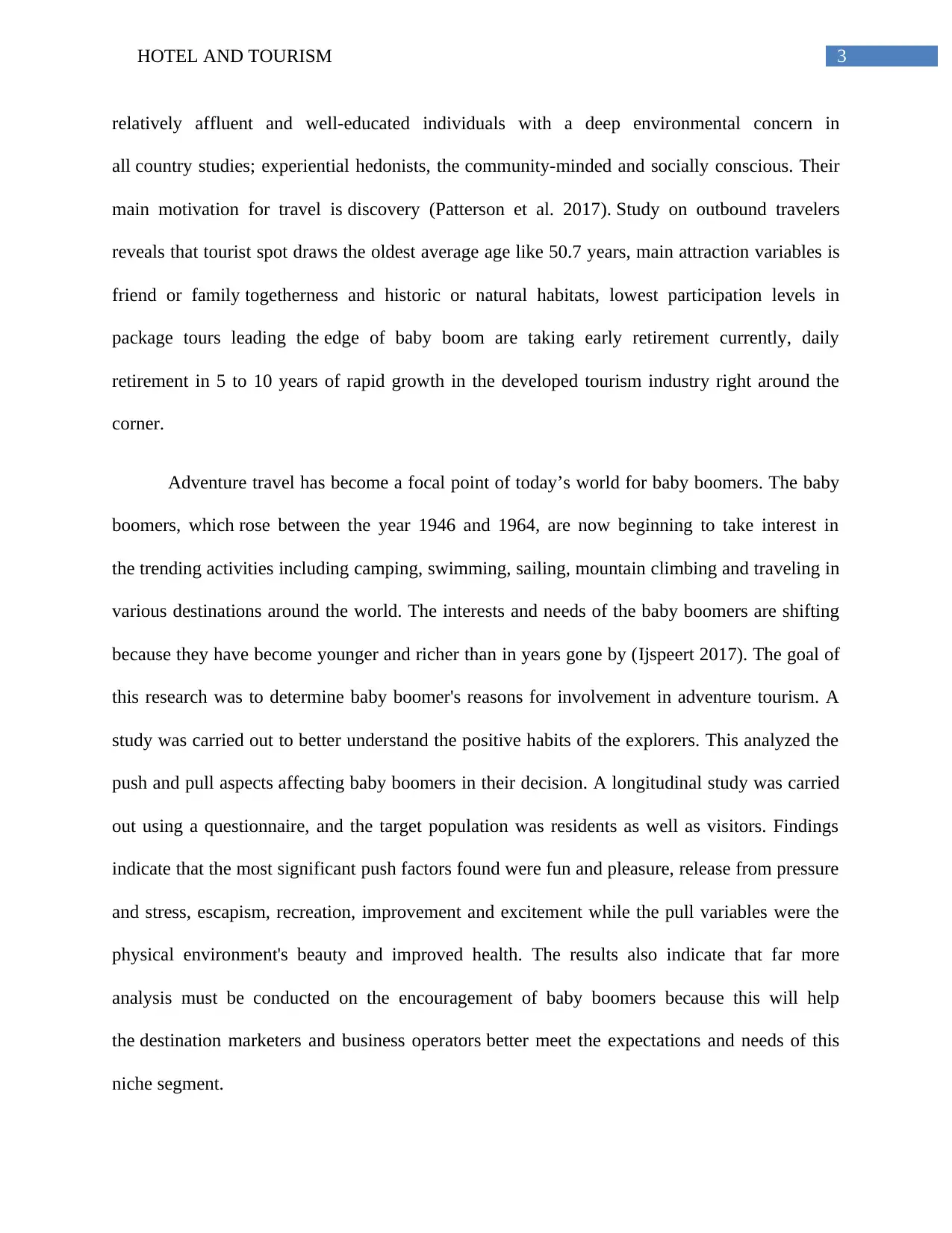
3HOTEL AND TOURISM
relatively affluent and well-educated individuals with a deep environmental concern in
all country studies; experiential hedonists, the community-minded and socially conscious. Their
main motivation for travel is discovery (Patterson et al. 2017). Study on outbound travelers
reveals that tourist spot draws the oldest average age like 50.7 years, main attraction variables is
friend or family togetherness and historic or natural habitats, lowest participation levels in
package tours leading the edge of baby boom are taking early retirement currently, daily
retirement in 5 to 10 years of rapid growth in the developed tourism industry right around the
corner.
Adventure travel has become a focal point of today’s world for baby boomers. The baby
boomers, which rose between the year 1946 and 1964, are now beginning to take interest in
the trending activities including camping, swimming, sailing, mountain climbing and traveling in
various destinations around the world. The interests and needs of the baby boomers are shifting
because they have become younger and richer than in years gone by (Ijspeert 2017). The goal of
this research was to determine baby boomer's reasons for involvement in adventure tourism. A
study was carried out to better understand the positive habits of the explorers. This analyzed the
push and pull aspects affecting baby boomers in their decision. A longitudinal study was carried
out using a questionnaire, and the target population was residents as well as visitors. Findings
indicate that the most significant push factors found were fun and pleasure, release from pressure
and stress, escapism, recreation, improvement and excitement while the pull variables were the
physical environment's beauty and improved health. The results also indicate that far more
analysis must be conducted on the encouragement of baby boomers because this will help
the destination marketers and business operators better meet the expectations and needs of this
niche segment.
relatively affluent and well-educated individuals with a deep environmental concern in
all country studies; experiential hedonists, the community-minded and socially conscious. Their
main motivation for travel is discovery (Patterson et al. 2017). Study on outbound travelers
reveals that tourist spot draws the oldest average age like 50.7 years, main attraction variables is
friend or family togetherness and historic or natural habitats, lowest participation levels in
package tours leading the edge of baby boom are taking early retirement currently, daily
retirement in 5 to 10 years of rapid growth in the developed tourism industry right around the
corner.
Adventure travel has become a focal point of today’s world for baby boomers. The baby
boomers, which rose between the year 1946 and 1964, are now beginning to take interest in
the trending activities including camping, swimming, sailing, mountain climbing and traveling in
various destinations around the world. The interests and needs of the baby boomers are shifting
because they have become younger and richer than in years gone by (Ijspeert 2017). The goal of
this research was to determine baby boomer's reasons for involvement in adventure tourism. A
study was carried out to better understand the positive habits of the explorers. This analyzed the
push and pull aspects affecting baby boomers in their decision. A longitudinal study was carried
out using a questionnaire, and the target population was residents as well as visitors. Findings
indicate that the most significant push factors found were fun and pleasure, release from pressure
and stress, escapism, recreation, improvement and excitement while the pull variables were the
physical environment's beauty and improved health. The results also indicate that far more
analysis must be conducted on the encouragement of baby boomers because this will help
the destination marketers and business operators better meet the expectations and needs of this
niche segment.
Secure Best Marks with AI Grader
Need help grading? Try our AI Grader for instant feedback on your assignments.
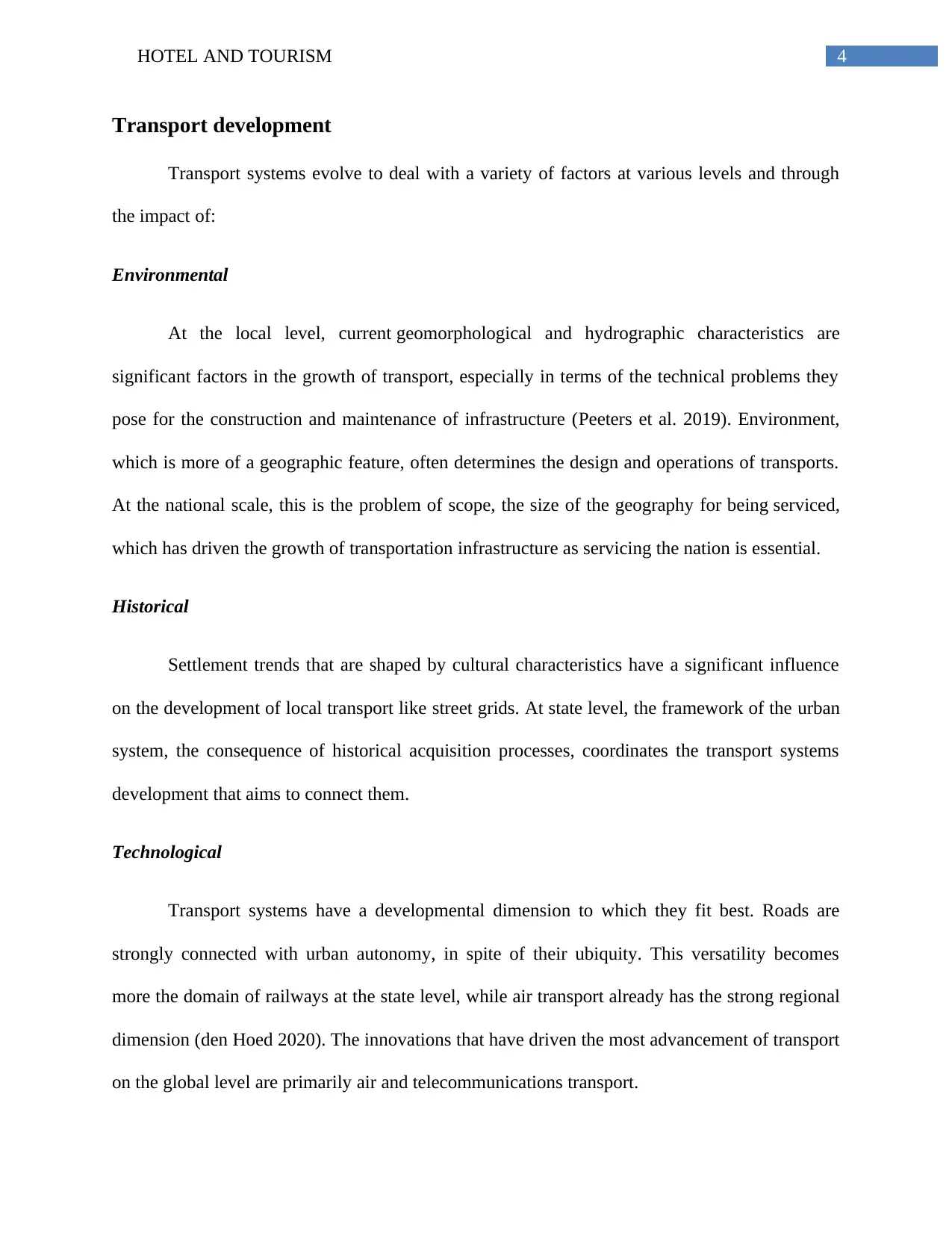
4HOTEL AND TOURISM
Transport development
Transport systems evolve to deal with a variety of factors at various levels and through
the impact of:
Environmental
At the local level, current geomorphological and hydrographic characteristics are
significant factors in the growth of transport, especially in terms of the technical problems they
pose for the construction and maintenance of infrastructure (Peeters et al. 2019). Environment,
which is more of a geographic feature, often determines the design and operations of transports.
At the national scale, this is the problem of scope, the size of the geography for being serviced,
which has driven the growth of transportation infrastructure as servicing the nation is essential.
Historical
Settlement trends that are shaped by cultural characteristics have a significant influence
on the development of local transport like street grids. At state level, the framework of the urban
system, the consequence of historical acquisition processes, coordinates the transport systems
development that aims to connect them.
Technological
Transport systems have a developmental dimension to which they fit best. Roads are
strongly connected with urban autonomy, in spite of their ubiquity. This versatility becomes
more the domain of railways at the state level, while air transport already has the strong regional
dimension (den Hoed 2020). The innovations that have driven the most advancement of transport
on the global level are primarily air and telecommunications transport.
Transport development
Transport systems evolve to deal with a variety of factors at various levels and through
the impact of:
Environmental
At the local level, current geomorphological and hydrographic characteristics are
significant factors in the growth of transport, especially in terms of the technical problems they
pose for the construction and maintenance of infrastructure (Peeters et al. 2019). Environment,
which is more of a geographic feature, often determines the design and operations of transports.
At the national scale, this is the problem of scope, the size of the geography for being serviced,
which has driven the growth of transportation infrastructure as servicing the nation is essential.
Historical
Settlement trends that are shaped by cultural characteristics have a significant influence
on the development of local transport like street grids. At state level, the framework of the urban
system, the consequence of historical acquisition processes, coordinates the transport systems
development that aims to connect them.
Technological
Transport systems have a developmental dimension to which they fit best. Roads are
strongly connected with urban autonomy, in spite of their ubiquity. This versatility becomes
more the domain of railways at the state level, while air transport already has the strong regional
dimension (den Hoed 2020). The innovations that have driven the most advancement of transport
on the global level are primarily air and telecommunications transport.
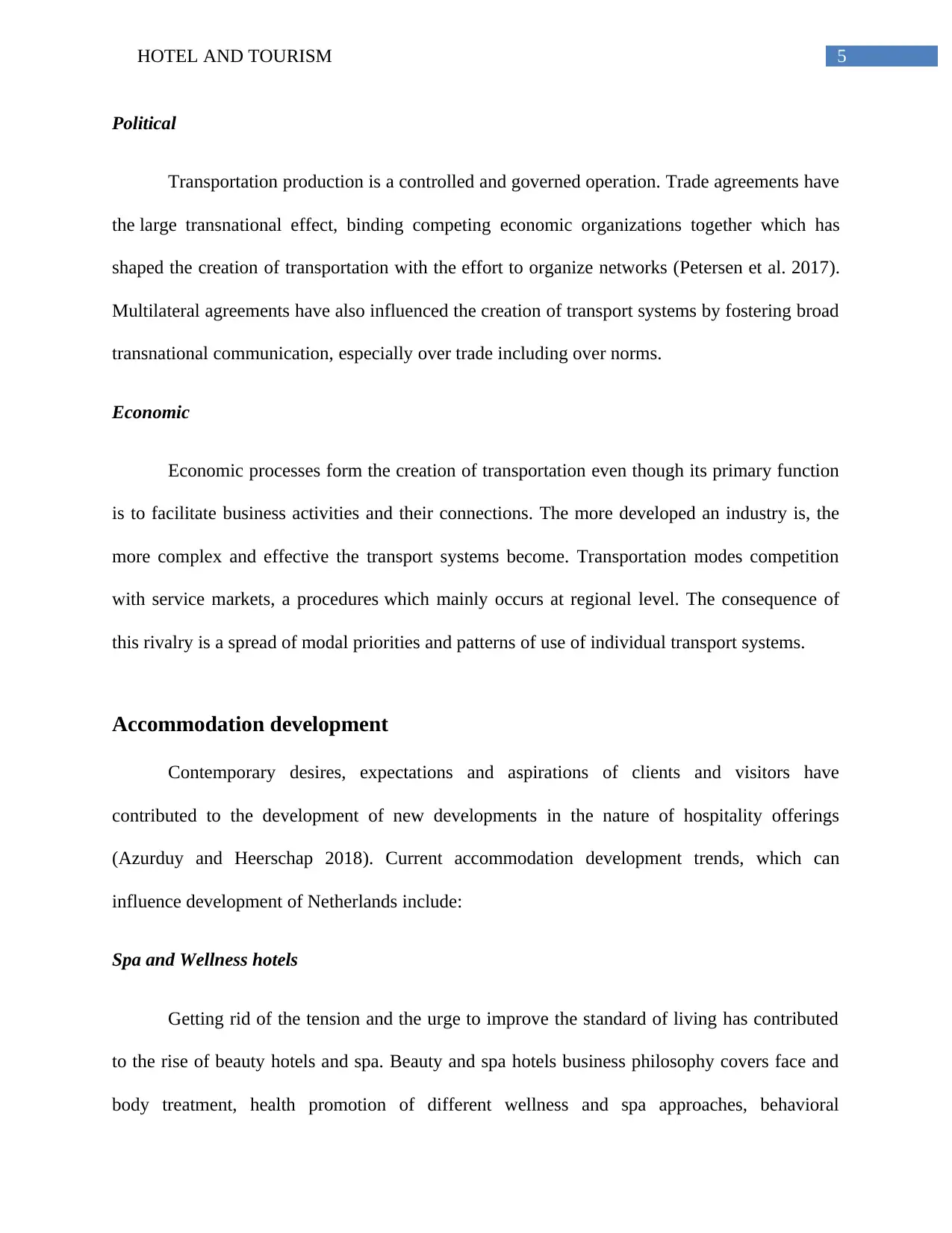
5HOTEL AND TOURISM
Political
Transportation production is a controlled and governed operation. Trade agreements have
the large transnational effect, binding competing economic organizations together which has
shaped the creation of transportation with the effort to organize networks (Petersen et al. 2017).
Multilateral agreements have also influenced the creation of transport systems by fostering broad
transnational communication, especially over trade including over norms.
Economic
Economic processes form the creation of transportation even though its primary function
is to facilitate business activities and their connections. The more developed an industry is, the
more complex and effective the transport systems become. Transportation modes competition
with service markets, a procedures which mainly occurs at regional level. The consequence of
this rivalry is a spread of modal priorities and patterns of use of individual transport systems.
Accommodation development
Contemporary desires, expectations and aspirations of clients and visitors have
contributed to the development of new developments in the nature of hospitality offerings
(Azurduy and Heerschap 2018). Current accommodation development trends, which can
influence development of Netherlands include:
Spa and Wellness hotels
Getting rid of the tension and the urge to improve the standard of living has contributed
to the rise of beauty hotels and spa. Beauty and spa hotels business philosophy covers face and
body treatment, health promotion of different wellness and spa approaches, behavioral
Political
Transportation production is a controlled and governed operation. Trade agreements have
the large transnational effect, binding competing economic organizations together which has
shaped the creation of transportation with the effort to organize networks (Petersen et al. 2017).
Multilateral agreements have also influenced the creation of transport systems by fostering broad
transnational communication, especially over trade including over norms.
Economic
Economic processes form the creation of transportation even though its primary function
is to facilitate business activities and their connections. The more developed an industry is, the
more complex and effective the transport systems become. Transportation modes competition
with service markets, a procedures which mainly occurs at regional level. The consequence of
this rivalry is a spread of modal priorities and patterns of use of individual transport systems.
Accommodation development
Contemporary desires, expectations and aspirations of clients and visitors have
contributed to the development of new developments in the nature of hospitality offerings
(Azurduy and Heerschap 2018). Current accommodation development trends, which can
influence development of Netherlands include:
Spa and Wellness hotels
Getting rid of the tension and the urge to improve the standard of living has contributed
to the rise of beauty hotels and spa. Beauty and spa hotels business philosophy covers face and
body treatment, health promotion of different wellness and spa approaches, behavioral
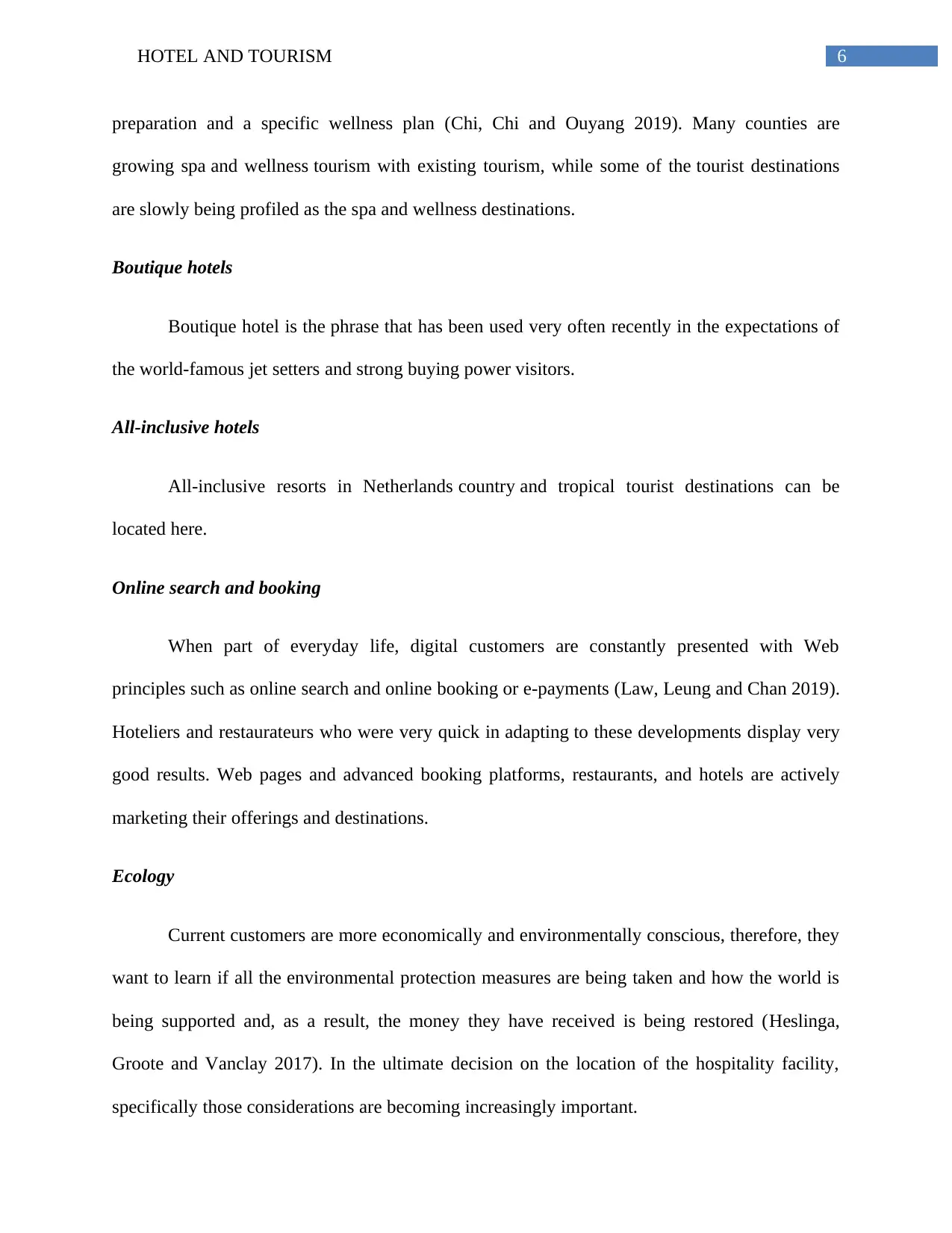
6HOTEL AND TOURISM
preparation and a specific wellness plan (Chi, Chi and Ouyang 2019). Many counties are
growing spa and wellness tourism with existing tourism, while some of the tourist destinations
are slowly being profiled as the spa and wellness destinations.
Boutique hotels
Boutique hotel is the phrase that has been used very often recently in the expectations of
the world-famous jet setters and strong buying power visitors.
All-inclusive hotels
All-inclusive resorts in Netherlands country and tropical tourist destinations can be
located here.
Online search and booking
When part of everyday life, digital customers are constantly presented with Web
principles such as online search and online booking or e-payments (Law, Leung and Chan 2019).
Hoteliers and restaurateurs who were very quick in adapting to these developments display very
good results. Web pages and advanced booking platforms, restaurants, and hotels are actively
marketing their offerings and destinations.
Ecology
Current customers are more economically and environmentally conscious, therefore, they
want to learn if all the environmental protection measures are being taken and how the world is
being supported and, as a result, the money they have received is being restored (Heslinga,
Groote and Vanclay 2017). In the ultimate decision on the location of the hospitality facility,
specifically those considerations are becoming increasingly important.
preparation and a specific wellness plan (Chi, Chi and Ouyang 2019). Many counties are
growing spa and wellness tourism with existing tourism, while some of the tourist destinations
are slowly being profiled as the spa and wellness destinations.
Boutique hotels
Boutique hotel is the phrase that has been used very often recently in the expectations of
the world-famous jet setters and strong buying power visitors.
All-inclusive hotels
All-inclusive resorts in Netherlands country and tropical tourist destinations can be
located here.
Online search and booking
When part of everyday life, digital customers are constantly presented with Web
principles such as online search and online booking or e-payments (Law, Leung and Chan 2019).
Hoteliers and restaurateurs who were very quick in adapting to these developments display very
good results. Web pages and advanced booking platforms, restaurants, and hotels are actively
marketing their offerings and destinations.
Ecology
Current customers are more economically and environmentally conscious, therefore, they
want to learn if all the environmental protection measures are being taken and how the world is
being supported and, as a result, the money they have received is being restored (Heslinga,
Groote and Vanclay 2017). In the ultimate decision on the location of the hospitality facility,
specifically those considerations are becoming increasingly important.
Paraphrase This Document
Need a fresh take? Get an instant paraphrase of this document with our AI Paraphraser
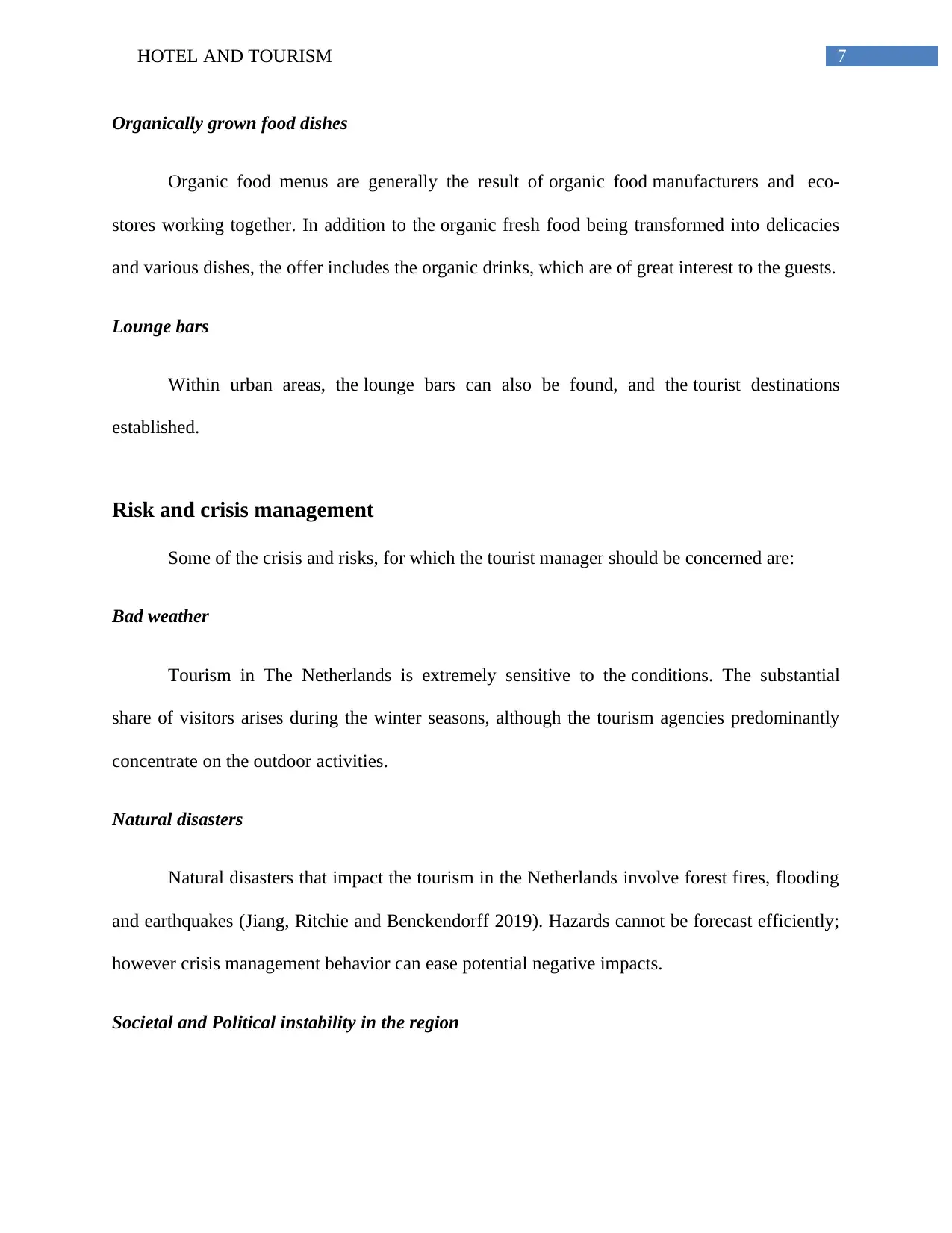
7HOTEL AND TOURISM
Organically grown food dishes
Organic food menus are generally the result of organic food manufacturers and eco-
stores working together. In addition to the organic fresh food being transformed into delicacies
and various dishes, the offer includes the organic drinks, which are of great interest to the guests.
Lounge bars
Within urban areas, the lounge bars can also be found, and the tourist destinations
established.
Risk and crisis management
Some of the crisis and risks, for which the tourist manager should be concerned are:
Bad weather
Tourism in The Netherlands is extremely sensitive to the conditions. The substantial
share of visitors arises during the winter seasons, although the tourism agencies predominantly
concentrate on the outdoor activities.
Natural disasters
Natural disasters that impact the tourism in the Netherlands involve forest fires, flooding
and earthquakes (Jiang, Ritchie and Benckendorff 2019). Hazards cannot be forecast efficiently;
however crisis management behavior can ease potential negative impacts.
Societal and Political instability in the region
Organically grown food dishes
Organic food menus are generally the result of organic food manufacturers and eco-
stores working together. In addition to the organic fresh food being transformed into delicacies
and various dishes, the offer includes the organic drinks, which are of great interest to the guests.
Lounge bars
Within urban areas, the lounge bars can also be found, and the tourist destinations
established.
Risk and crisis management
Some of the crisis and risks, for which the tourist manager should be concerned are:
Bad weather
Tourism in The Netherlands is extremely sensitive to the conditions. The substantial
share of visitors arises during the winter seasons, although the tourism agencies predominantly
concentrate on the outdoor activities.
Natural disasters
Natural disasters that impact the tourism in the Netherlands involve forest fires, flooding
and earthquakes (Jiang, Ritchie and Benckendorff 2019). Hazards cannot be forecast efficiently;
however crisis management behavior can ease potential negative impacts.
Societal and Political instability in the region
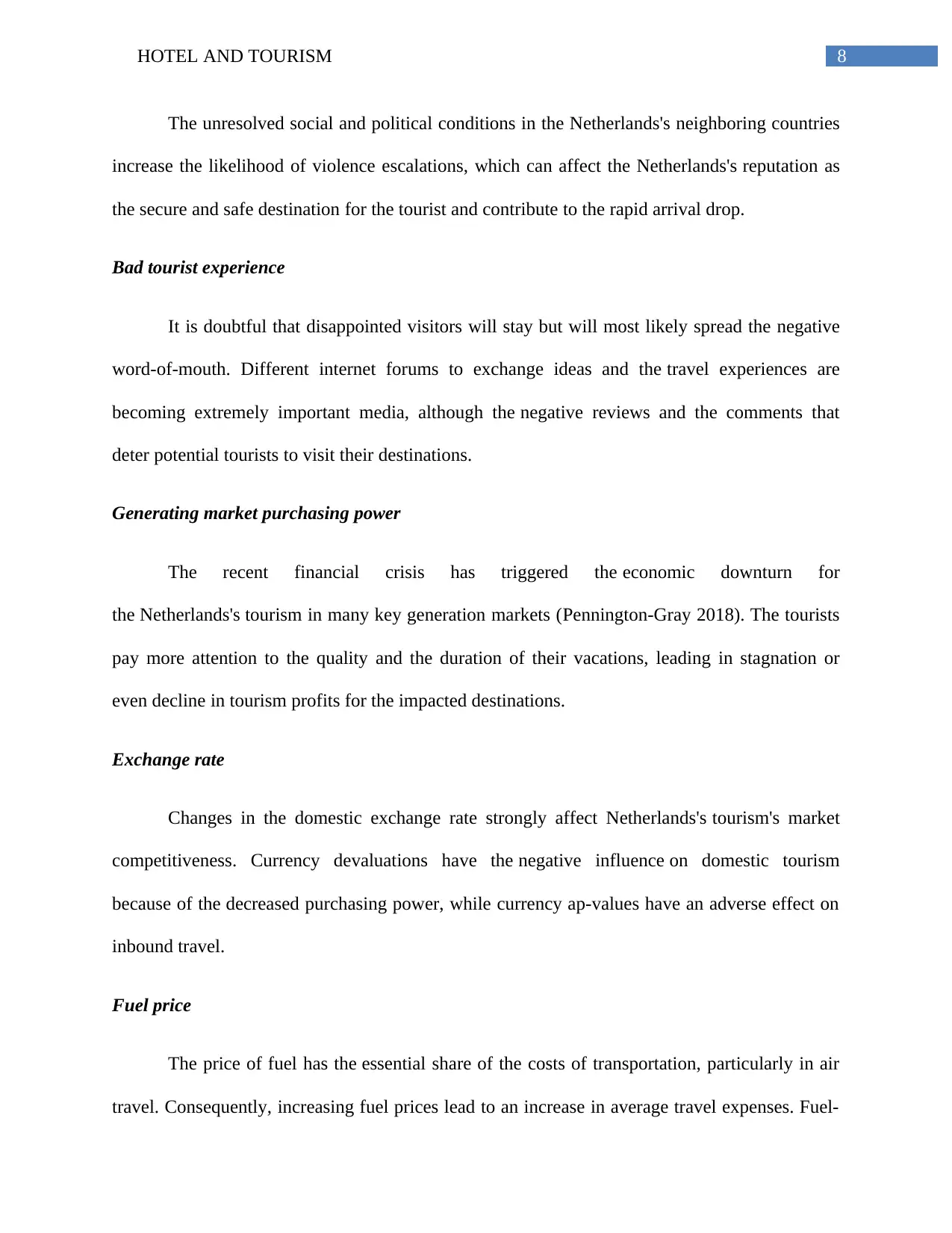
8HOTEL AND TOURISM
The unresolved social and political conditions in the Netherlands's neighboring countries
increase the likelihood of violence escalations, which can affect the Netherlands's reputation as
the secure and safe destination for the tourist and contribute to the rapid arrival drop.
Bad tourist experience
It is doubtful that disappointed visitors will stay but will most likely spread the negative
word-of-mouth. Different internet forums to exchange ideas and the travel experiences are
becoming extremely important media, although the negative reviews and the comments that
deter potential tourists to visit their destinations.
Generating market purchasing power
The recent financial crisis has triggered the economic downturn for
the Netherlands's tourism in many key generation markets (Pennington-Gray 2018). The tourists
pay more attention to the quality and the duration of their vacations, leading in stagnation or
even decline in tourism profits for the impacted destinations.
Exchange rate
Changes in the domestic exchange rate strongly affect Netherlands's tourism's market
competitiveness. Currency devaluations have the negative influence on domestic tourism
because of the decreased purchasing power, while currency ap-values have an adverse effect on
inbound travel.
Fuel price
The price of fuel has the essential share of the costs of transportation, particularly in air
travel. Consequently, increasing fuel prices lead to an increase in average travel expenses. Fuel-
The unresolved social and political conditions in the Netherlands's neighboring countries
increase the likelihood of violence escalations, which can affect the Netherlands's reputation as
the secure and safe destination for the tourist and contribute to the rapid arrival drop.
Bad tourist experience
It is doubtful that disappointed visitors will stay but will most likely spread the negative
word-of-mouth. Different internet forums to exchange ideas and the travel experiences are
becoming extremely important media, although the negative reviews and the comments that
deter potential tourists to visit their destinations.
Generating market purchasing power
The recent financial crisis has triggered the economic downturn for
the Netherlands's tourism in many key generation markets (Pennington-Gray 2018). The tourists
pay more attention to the quality and the duration of their vacations, leading in stagnation or
even decline in tourism profits for the impacted destinations.
Exchange rate
Changes in the domestic exchange rate strongly affect Netherlands's tourism's market
competitiveness. Currency devaluations have the negative influence on domestic tourism
because of the decreased purchasing power, while currency ap-values have an adverse effect on
inbound travel.
Fuel price
The price of fuel has the essential share of the costs of transportation, particularly in air
travel. Consequently, increasing fuel prices lead to an increase in average travel expenses. Fuel-
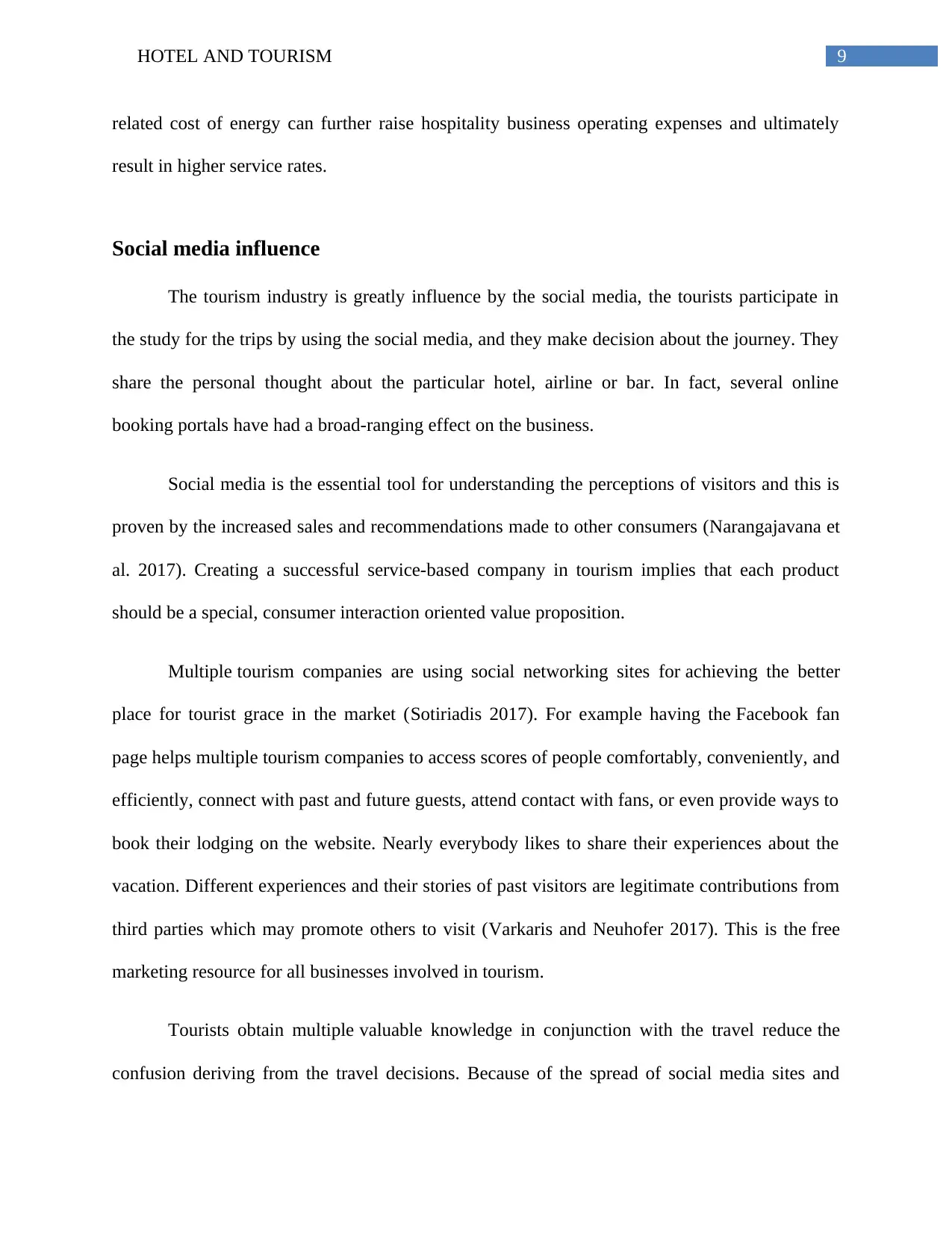
9HOTEL AND TOURISM
related cost of energy can further raise hospitality business operating expenses and ultimately
result in higher service rates.
Social media influence
The tourism industry is greatly influence by the social media, the tourists participate in
the study for the trips by using the social media, and they make decision about the journey. They
share the personal thought about the particular hotel, airline or bar. In fact, several online
booking portals have had a broad-ranging effect on the business.
Social media is the essential tool for understanding the perceptions of visitors and this is
proven by the increased sales and recommendations made to other consumers (Narangajavana et
al. 2017). Creating a successful service-based company in tourism implies that each product
should be a special, consumer interaction oriented value proposition.
Multiple tourism companies are using social networking sites for achieving the better
place for tourist grace in the market (Sotiriadis 2017). For example having the Facebook fan
page helps multiple tourism companies to access scores of people comfortably, conveniently, and
efficiently, connect with past and future guests, attend contact with fans, or even provide ways to
book their lodging on the website. Nearly everybody likes to share their experiences about the
vacation. Different experiences and their stories of past visitors are legitimate contributions from
third parties which may promote others to visit (Varkaris and Neuhofer 2017). This is the free
marketing resource for all businesses involved in tourism.
Tourists obtain multiple valuable knowledge in conjunction with the travel reduce the
confusion deriving from the travel decisions. Because of the spread of social media sites and
related cost of energy can further raise hospitality business operating expenses and ultimately
result in higher service rates.
Social media influence
The tourism industry is greatly influence by the social media, the tourists participate in
the study for the trips by using the social media, and they make decision about the journey. They
share the personal thought about the particular hotel, airline or bar. In fact, several online
booking portals have had a broad-ranging effect on the business.
Social media is the essential tool for understanding the perceptions of visitors and this is
proven by the increased sales and recommendations made to other consumers (Narangajavana et
al. 2017). Creating a successful service-based company in tourism implies that each product
should be a special, consumer interaction oriented value proposition.
Multiple tourism companies are using social networking sites for achieving the better
place for tourist grace in the market (Sotiriadis 2017). For example having the Facebook fan
page helps multiple tourism companies to access scores of people comfortably, conveniently, and
efficiently, connect with past and future guests, attend contact with fans, or even provide ways to
book their lodging on the website. Nearly everybody likes to share their experiences about the
vacation. Different experiences and their stories of past visitors are legitimate contributions from
third parties which may promote others to visit (Varkaris and Neuhofer 2017). This is the free
marketing resource for all businesses involved in tourism.
Tourists obtain multiple valuable knowledge in conjunction with the travel reduce the
confusion deriving from the travel decisions. Because of the spread of social media sites and
Secure Best Marks with AI Grader
Need help grading? Try our AI Grader for instant feedback on your assignments.
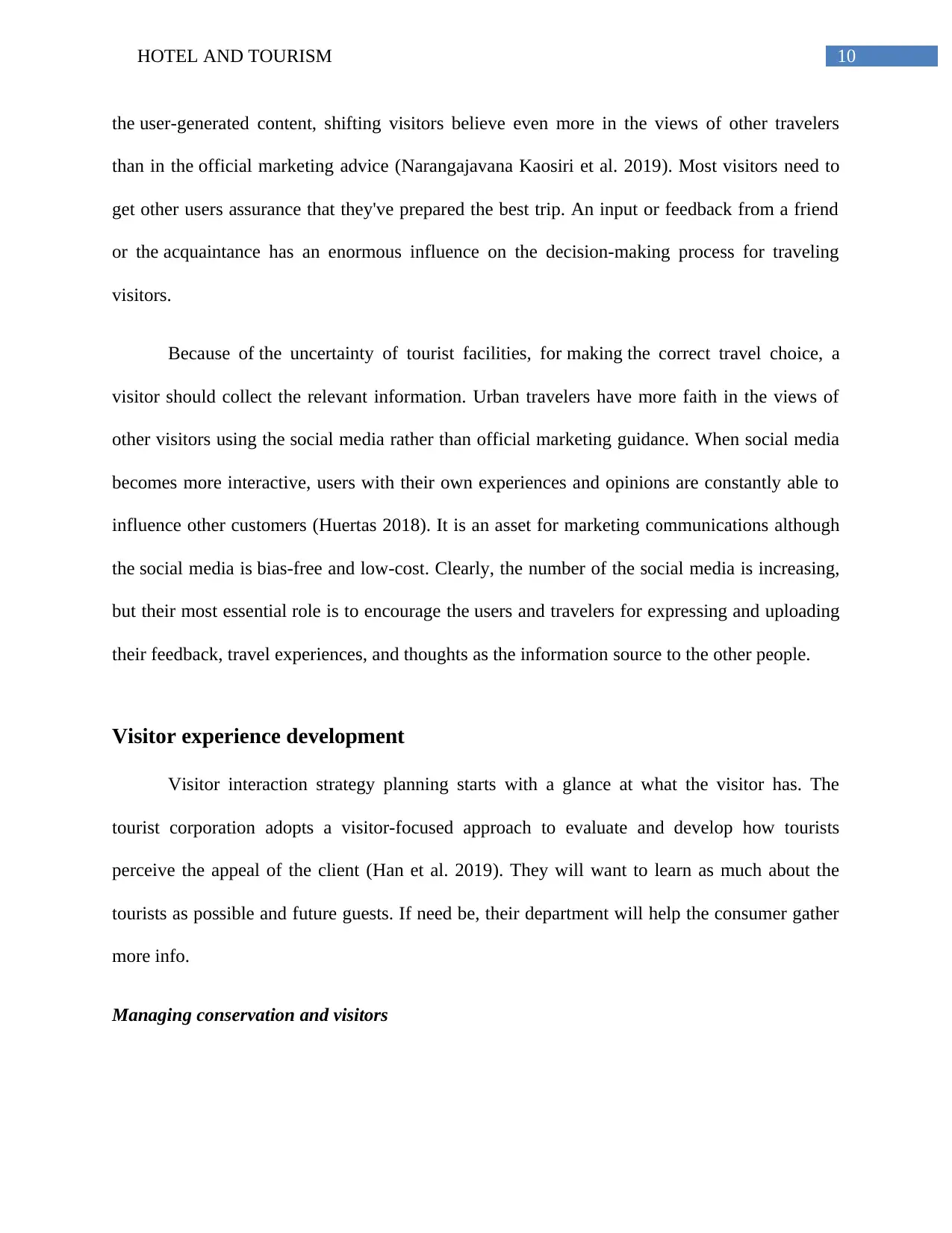
10HOTEL AND TOURISM
the user-generated content, shifting visitors believe even more in the views of other travelers
than in the official marketing advice (Narangajavana Kaosiri et al. 2019). Most visitors need to
get other users assurance that they've prepared the best trip. An input or feedback from a friend
or the acquaintance has an enormous influence on the decision-making process for traveling
visitors.
Because of the uncertainty of tourist facilities, for making the correct travel choice, a
visitor should collect the relevant information. Urban travelers have more faith in the views of
other visitors using the social media rather than official marketing guidance. When social media
becomes more interactive, users with their own experiences and opinions are constantly able to
influence other customers (Huertas 2018). It is an asset for marketing communications although
the social media is bias-free and low-cost. Clearly, the number of the social media is increasing,
but their most essential role is to encourage the users and travelers for expressing and uploading
their feedback, travel experiences, and thoughts as the information source to the other people.
Visitor experience development
Visitor interaction strategy planning starts with a glance at what the visitor has. The
tourist corporation adopts a visitor-focused approach to evaluate and develop how tourists
perceive the appeal of the client (Han et al. 2019). They will want to learn as much about the
tourists as possible and future guests. If need be, their department will help the consumer gather
more info.
Managing conservation and visitors
the user-generated content, shifting visitors believe even more in the views of other travelers
than in the official marketing advice (Narangajavana Kaosiri et al. 2019). Most visitors need to
get other users assurance that they've prepared the best trip. An input or feedback from a friend
or the acquaintance has an enormous influence on the decision-making process for traveling
visitors.
Because of the uncertainty of tourist facilities, for making the correct travel choice, a
visitor should collect the relevant information. Urban travelers have more faith in the views of
other visitors using the social media rather than official marketing guidance. When social media
becomes more interactive, users with their own experiences and opinions are constantly able to
influence other customers (Huertas 2018). It is an asset for marketing communications although
the social media is bias-free and low-cost. Clearly, the number of the social media is increasing,
but their most essential role is to encourage the users and travelers for expressing and uploading
their feedback, travel experiences, and thoughts as the information source to the other people.
Visitor experience development
Visitor interaction strategy planning starts with a glance at what the visitor has. The
tourist corporation adopts a visitor-focused approach to evaluate and develop how tourists
perceive the appeal of the client (Han et al. 2019). They will want to learn as much about the
tourists as possible and future guests. If need be, their department will help the consumer gather
more info.
Managing conservation and visitors
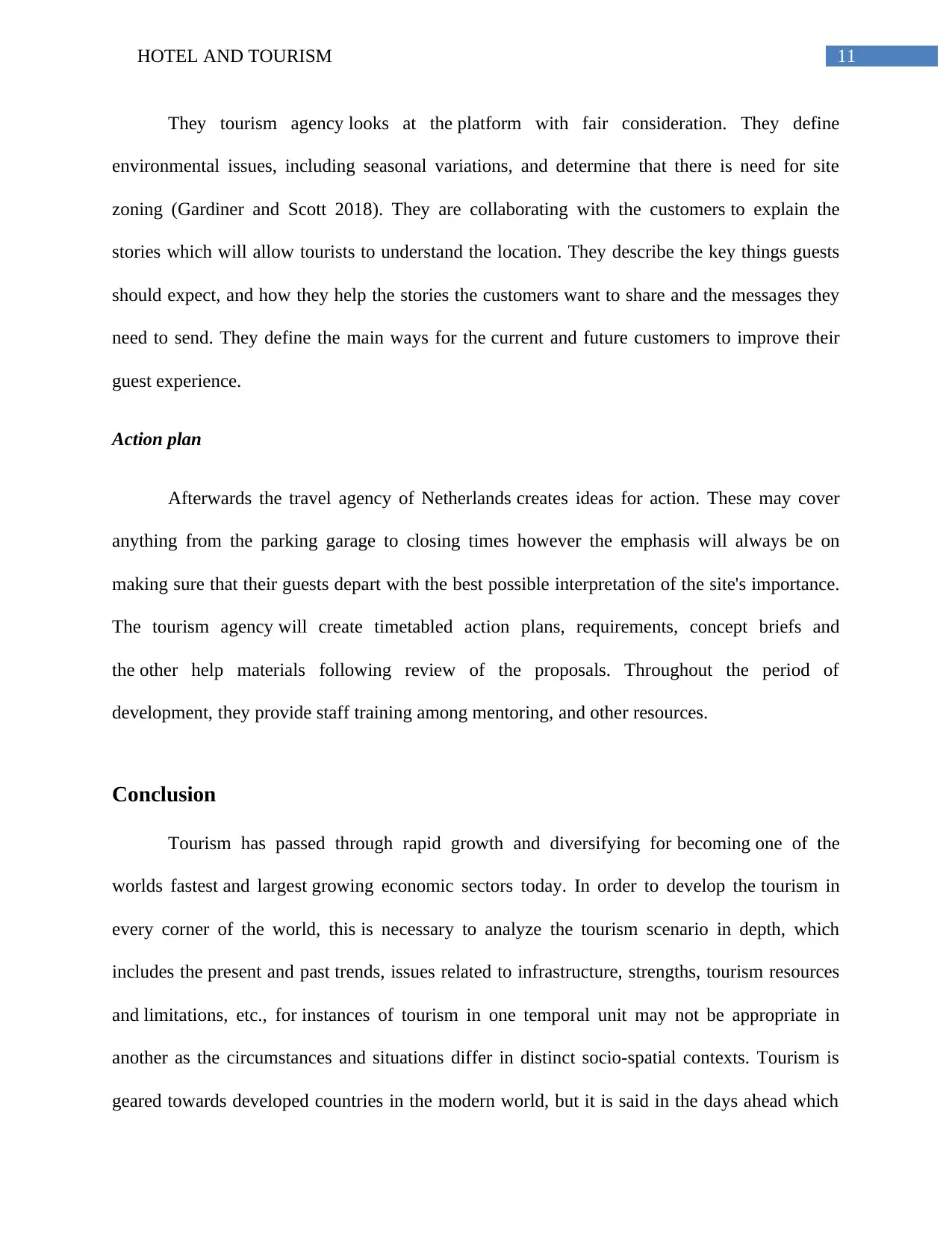
11HOTEL AND TOURISM
They tourism agency looks at the platform with fair consideration. They define
environmental issues, including seasonal variations, and determine that there is need for site
zoning (Gardiner and Scott 2018). They are collaborating with the customers to explain the
stories which will allow tourists to understand the location. They describe the key things guests
should expect, and how they help the stories the customers want to share and the messages they
need to send. They define the main ways for the current and future customers to improve their
guest experience.
Action plan
Afterwards the travel agency of Netherlands creates ideas for action. These may cover
anything from the parking garage to closing times however the emphasis will always be on
making sure that their guests depart with the best possible interpretation of the site's importance.
The tourism agency will create timetabled action plans, requirements, concept briefs and
the other help materials following review of the proposals. Throughout the period of
development, they provide staff training among mentoring, and other resources.
Conclusion
Tourism has passed through rapid growth and diversifying for becoming one of the
worlds fastest and largest growing economic sectors today. In order to develop the tourism in
every corner of the world, this is necessary to analyze the tourism scenario in depth, which
includes the present and past trends, issues related to infrastructure, strengths, tourism resources
and limitations, etc., for instances of tourism in one temporal unit may not be appropriate in
another as the circumstances and situations differ in distinct socio-spatial contexts. Tourism is
geared towards developed countries in the modern world, but it is said in the days ahead which
They tourism agency looks at the platform with fair consideration. They define
environmental issues, including seasonal variations, and determine that there is need for site
zoning (Gardiner and Scott 2018). They are collaborating with the customers to explain the
stories which will allow tourists to understand the location. They describe the key things guests
should expect, and how they help the stories the customers want to share and the messages they
need to send. They define the main ways for the current and future customers to improve their
guest experience.
Action plan
Afterwards the travel agency of Netherlands creates ideas for action. These may cover
anything from the parking garage to closing times however the emphasis will always be on
making sure that their guests depart with the best possible interpretation of the site's importance.
The tourism agency will create timetabled action plans, requirements, concept briefs and
the other help materials following review of the proposals. Throughout the period of
development, they provide staff training among mentoring, and other resources.
Conclusion
Tourism has passed through rapid growth and diversifying for becoming one of the
worlds fastest and largest growing economic sectors today. In order to develop the tourism in
every corner of the world, this is necessary to analyze the tourism scenario in depth, which
includes the present and past trends, issues related to infrastructure, strengths, tourism resources
and limitations, etc., for instances of tourism in one temporal unit may not be appropriate in
another as the circumstances and situations differ in distinct socio-spatial contexts. Tourism is
geared towards developed countries in the modern world, but it is said in the days ahead which
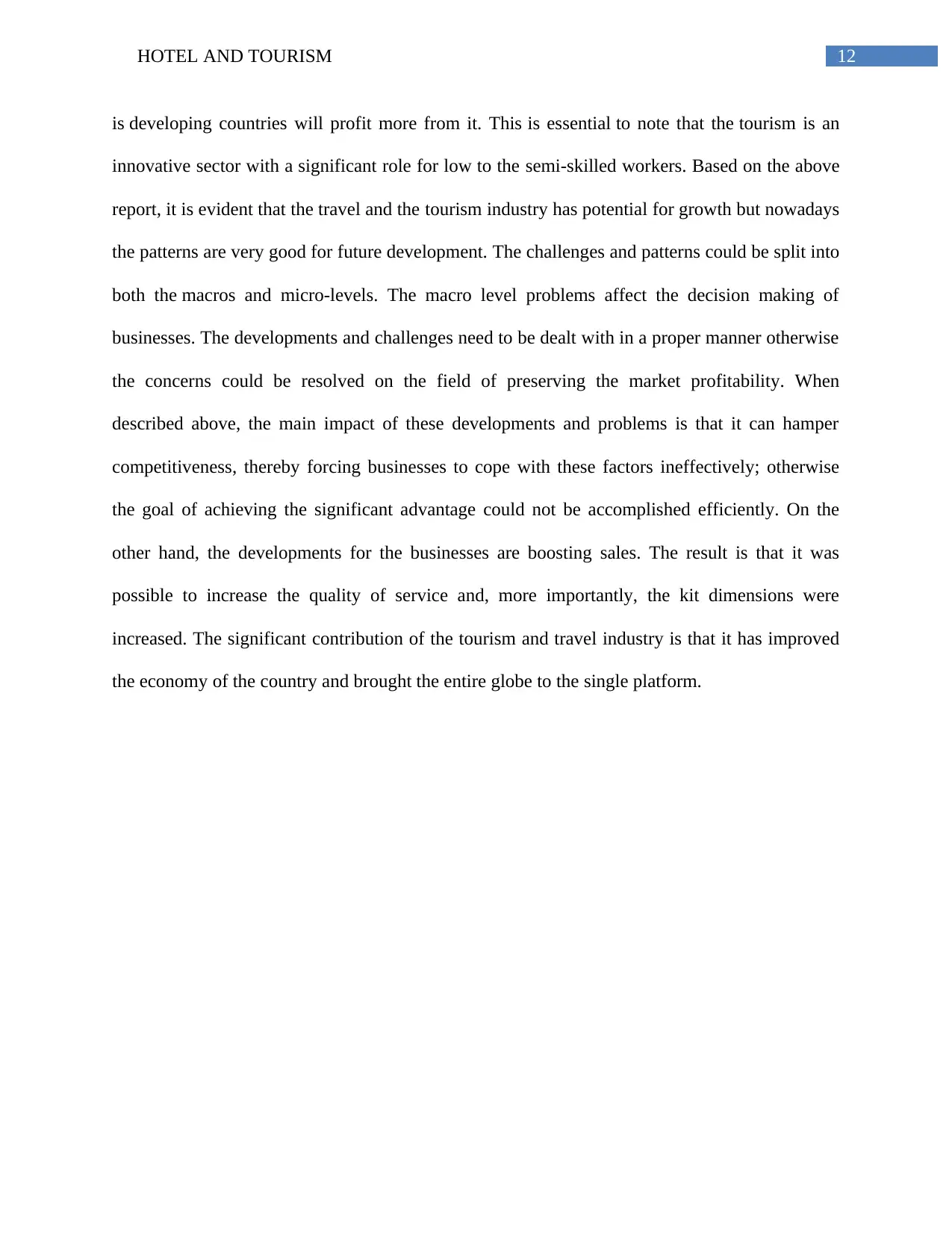
12HOTEL AND TOURISM
is developing countries will profit more from it. This is essential to note that the tourism is an
innovative sector with a significant role for low to the semi-skilled workers. Based on the above
report, it is evident that the travel and the tourism industry has potential for growth but nowadays
the patterns are very good for future development. The challenges and patterns could be split into
both the macros and micro-levels. The macro level problems affect the decision making of
businesses. The developments and challenges need to be dealt with in a proper manner otherwise
the concerns could be resolved on the field of preserving the market profitability. When
described above, the main impact of these developments and problems is that it can hamper
competitiveness, thereby forcing businesses to cope with these factors ineffectively; otherwise
the goal of achieving the significant advantage could not be accomplished efficiently. On the
other hand, the developments for the businesses are boosting sales. The result is that it was
possible to increase the quality of service and, more importantly, the kit dimensions were
increased. The significant contribution of the tourism and travel industry is that it has improved
the economy of the country and brought the entire globe to the single platform.
is developing countries will profit more from it. This is essential to note that the tourism is an
innovative sector with a significant role for low to the semi-skilled workers. Based on the above
report, it is evident that the travel and the tourism industry has potential for growth but nowadays
the patterns are very good for future development. The challenges and patterns could be split into
both the macros and micro-levels. The macro level problems affect the decision making of
businesses. The developments and challenges need to be dealt with in a proper manner otherwise
the concerns could be resolved on the field of preserving the market profitability. When
described above, the main impact of these developments and problems is that it can hamper
competitiveness, thereby forcing businesses to cope with these factors ineffectively; otherwise
the goal of achieving the significant advantage could not be accomplished efficiently. On the
other hand, the developments for the businesses are boosting sales. The result is that it was
possible to increase the quality of service and, more importantly, the kit dimensions were
increased. The significant contribution of the tourism and travel industry is that it has improved
the economy of the country and brought the entire globe to the single platform.
Paraphrase This Document
Need a fresh take? Get an instant paraphrase of this document with our AI Paraphraser
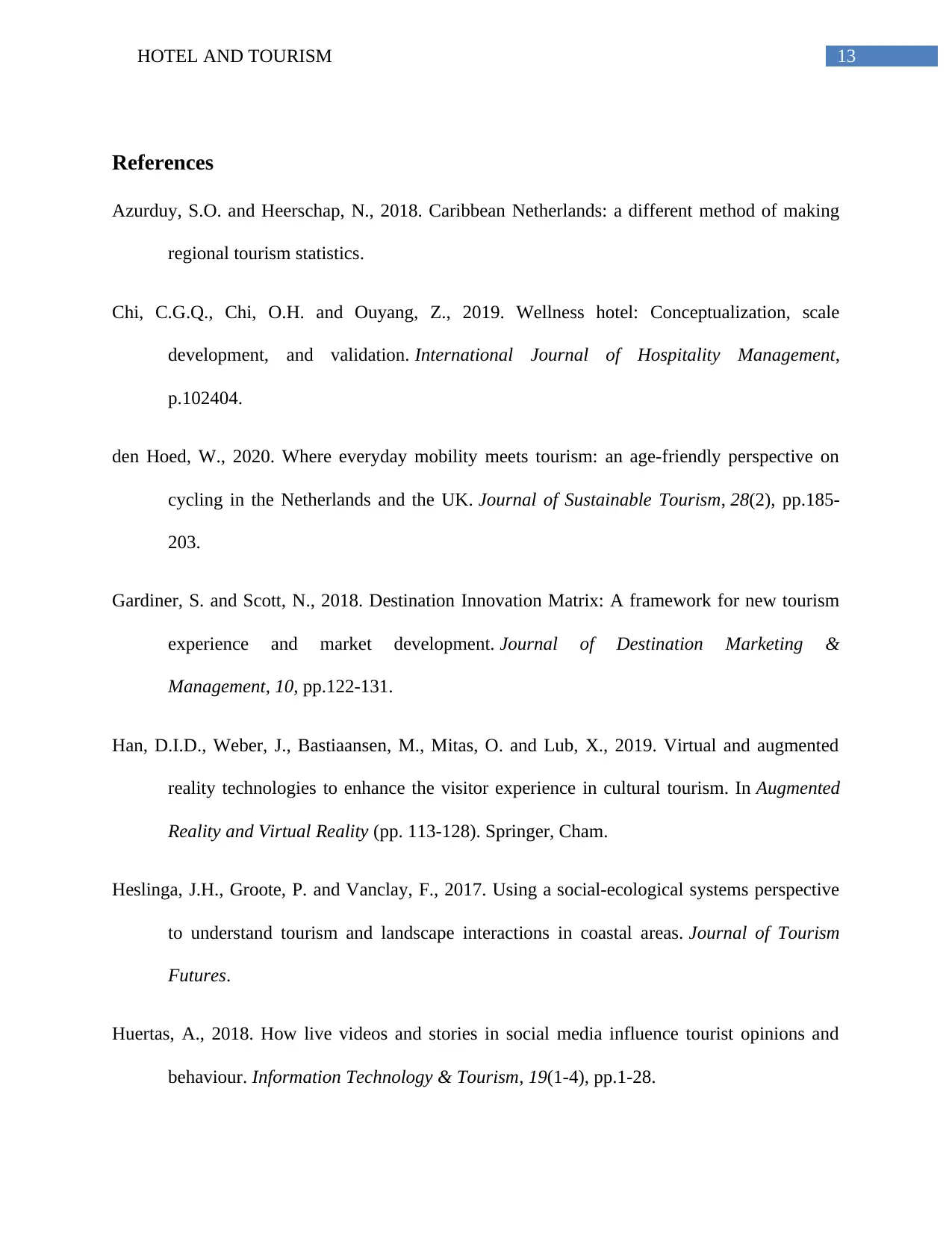
13HOTEL AND TOURISM
References
Azurduy, S.O. and Heerschap, N., 2018. Caribbean Netherlands: a different method of making
regional tourism statistics.
Chi, C.G.Q., Chi, O.H. and Ouyang, Z., 2019. Wellness hotel: Conceptualization, scale
development, and validation. International Journal of Hospitality Management,
p.102404.
den Hoed, W., 2020. Where everyday mobility meets tourism: an age-friendly perspective on
cycling in the Netherlands and the UK. Journal of Sustainable Tourism, 28(2), pp.185-
203.
Gardiner, S. and Scott, N., 2018. Destination Innovation Matrix: A framework for new tourism
experience and market development. Journal of Destination Marketing &
Management, 10, pp.122-131.
Han, D.I.D., Weber, J., Bastiaansen, M., Mitas, O. and Lub, X., 2019. Virtual and augmented
reality technologies to enhance the visitor experience in cultural tourism. In Augmented
Reality and Virtual Reality (pp. 113-128). Springer, Cham.
Heslinga, J.H., Groote, P. and Vanclay, F., 2017. Using a social-ecological systems perspective
to understand tourism and landscape interactions in coastal areas. Journal of Tourism
Futures.
Huertas, A., 2018. How live videos and stories in social media influence tourist opinions and
behaviour. Information Technology & Tourism, 19(1-4), pp.1-28.
References
Azurduy, S.O. and Heerschap, N., 2018. Caribbean Netherlands: a different method of making
regional tourism statistics.
Chi, C.G.Q., Chi, O.H. and Ouyang, Z., 2019. Wellness hotel: Conceptualization, scale
development, and validation. International Journal of Hospitality Management,
p.102404.
den Hoed, W., 2020. Where everyday mobility meets tourism: an age-friendly perspective on
cycling in the Netherlands and the UK. Journal of Sustainable Tourism, 28(2), pp.185-
203.
Gardiner, S. and Scott, N., 2018. Destination Innovation Matrix: A framework for new tourism
experience and market development. Journal of Destination Marketing &
Management, 10, pp.122-131.
Han, D.I.D., Weber, J., Bastiaansen, M., Mitas, O. and Lub, X., 2019. Virtual and augmented
reality technologies to enhance the visitor experience in cultural tourism. In Augmented
Reality and Virtual Reality (pp. 113-128). Springer, Cham.
Heslinga, J.H., Groote, P. and Vanclay, F., 2017. Using a social-ecological systems perspective
to understand tourism and landscape interactions in coastal areas. Journal of Tourism
Futures.
Huertas, A., 2018. How live videos and stories in social media influence tourist opinions and
behaviour. Information Technology & Tourism, 19(1-4), pp.1-28.
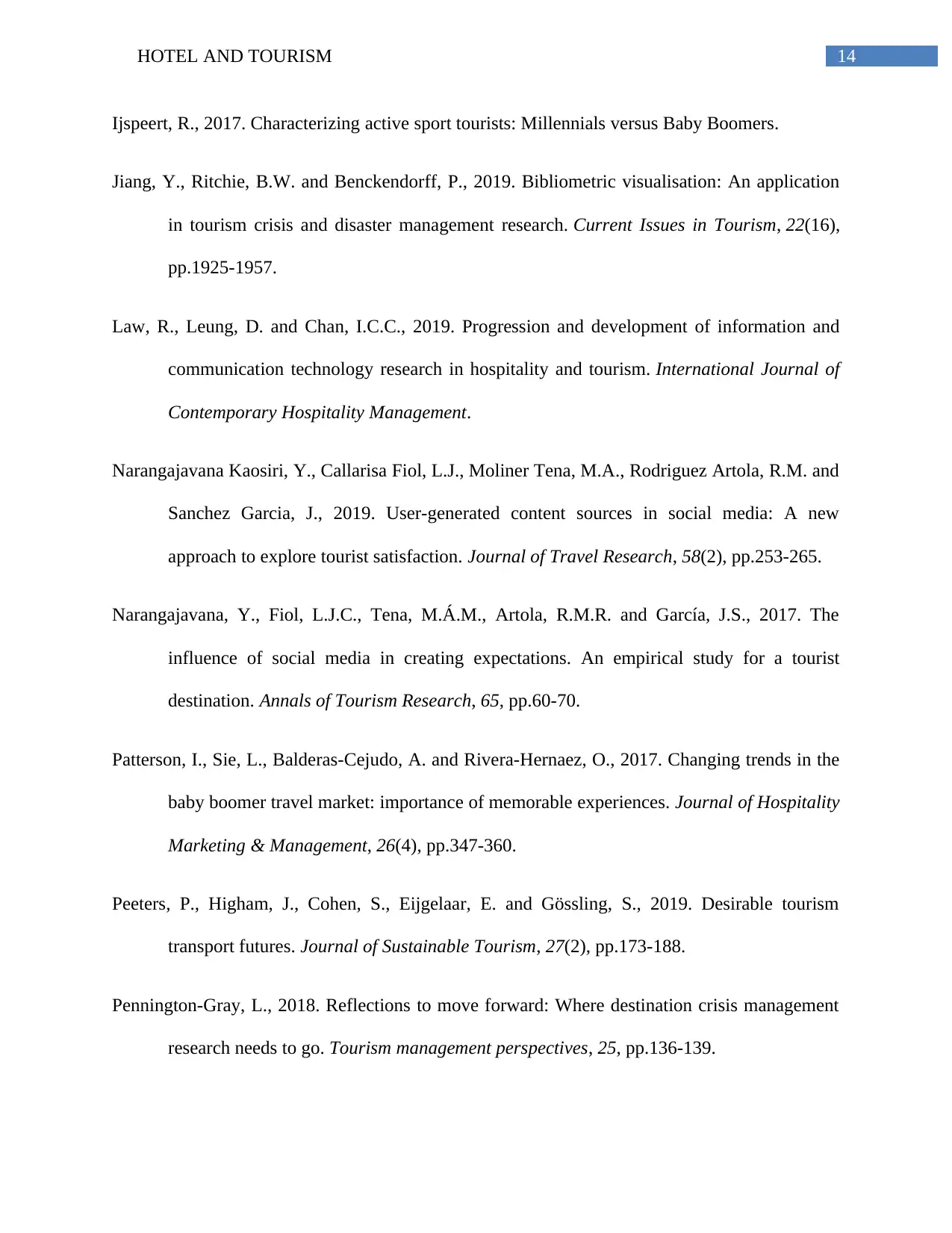
14HOTEL AND TOURISM
Ijspeert, R., 2017. Characterizing active sport tourists: Millennials versus Baby Boomers.
Jiang, Y., Ritchie, B.W. and Benckendorff, P., 2019. Bibliometric visualisation: An application
in tourism crisis and disaster management research. Current Issues in Tourism, 22(16),
pp.1925-1957.
Law, R., Leung, D. and Chan, I.C.C., 2019. Progression and development of information and
communication technology research in hospitality and tourism. International Journal of
Contemporary Hospitality Management.
Narangajavana Kaosiri, Y., Callarisa Fiol, L.J., Moliner Tena, M.A., Rodriguez Artola, R.M. and
Sanchez Garcia, J., 2019. User-generated content sources in social media: A new
approach to explore tourist satisfaction. Journal of Travel Research, 58(2), pp.253-265.
Narangajavana, Y., Fiol, L.J.C., Tena, M.Á.M., Artola, R.M.R. and García, J.S., 2017. The
influence of social media in creating expectations. An empirical study for a tourist
destination. Annals of Tourism Research, 65, pp.60-70.
Patterson, I., Sie, L., Balderas-Cejudo, A. and Rivera-Hernaez, O., 2017. Changing trends in the
baby boomer travel market: importance of memorable experiences. Journal of Hospitality
Marketing & Management, 26(4), pp.347-360.
Peeters, P., Higham, J., Cohen, S., Eijgelaar, E. and Gössling, S., 2019. Desirable tourism
transport futures. Journal of Sustainable Tourism, 27(2), pp.173-188.
Pennington-Gray, L., 2018. Reflections to move forward: Where destination crisis management
research needs to go. Tourism management perspectives, 25, pp.136-139.
Ijspeert, R., 2017. Characterizing active sport tourists: Millennials versus Baby Boomers.
Jiang, Y., Ritchie, B.W. and Benckendorff, P., 2019. Bibliometric visualisation: An application
in tourism crisis and disaster management research. Current Issues in Tourism, 22(16),
pp.1925-1957.
Law, R., Leung, D. and Chan, I.C.C., 2019. Progression and development of information and
communication technology research in hospitality and tourism. International Journal of
Contemporary Hospitality Management.
Narangajavana Kaosiri, Y., Callarisa Fiol, L.J., Moliner Tena, M.A., Rodriguez Artola, R.M. and
Sanchez Garcia, J., 2019. User-generated content sources in social media: A new
approach to explore tourist satisfaction. Journal of Travel Research, 58(2), pp.253-265.
Narangajavana, Y., Fiol, L.J.C., Tena, M.Á.M., Artola, R.M.R. and García, J.S., 2017. The
influence of social media in creating expectations. An empirical study for a tourist
destination. Annals of Tourism Research, 65, pp.60-70.
Patterson, I., Sie, L., Balderas-Cejudo, A. and Rivera-Hernaez, O., 2017. Changing trends in the
baby boomer travel market: importance of memorable experiences. Journal of Hospitality
Marketing & Management, 26(4), pp.347-360.
Peeters, P., Higham, J., Cohen, S., Eijgelaar, E. and Gössling, S., 2019. Desirable tourism
transport futures. Journal of Sustainable Tourism, 27(2), pp.173-188.
Pennington-Gray, L., 2018. Reflections to move forward: Where destination crisis management
research needs to go. Tourism management perspectives, 25, pp.136-139.
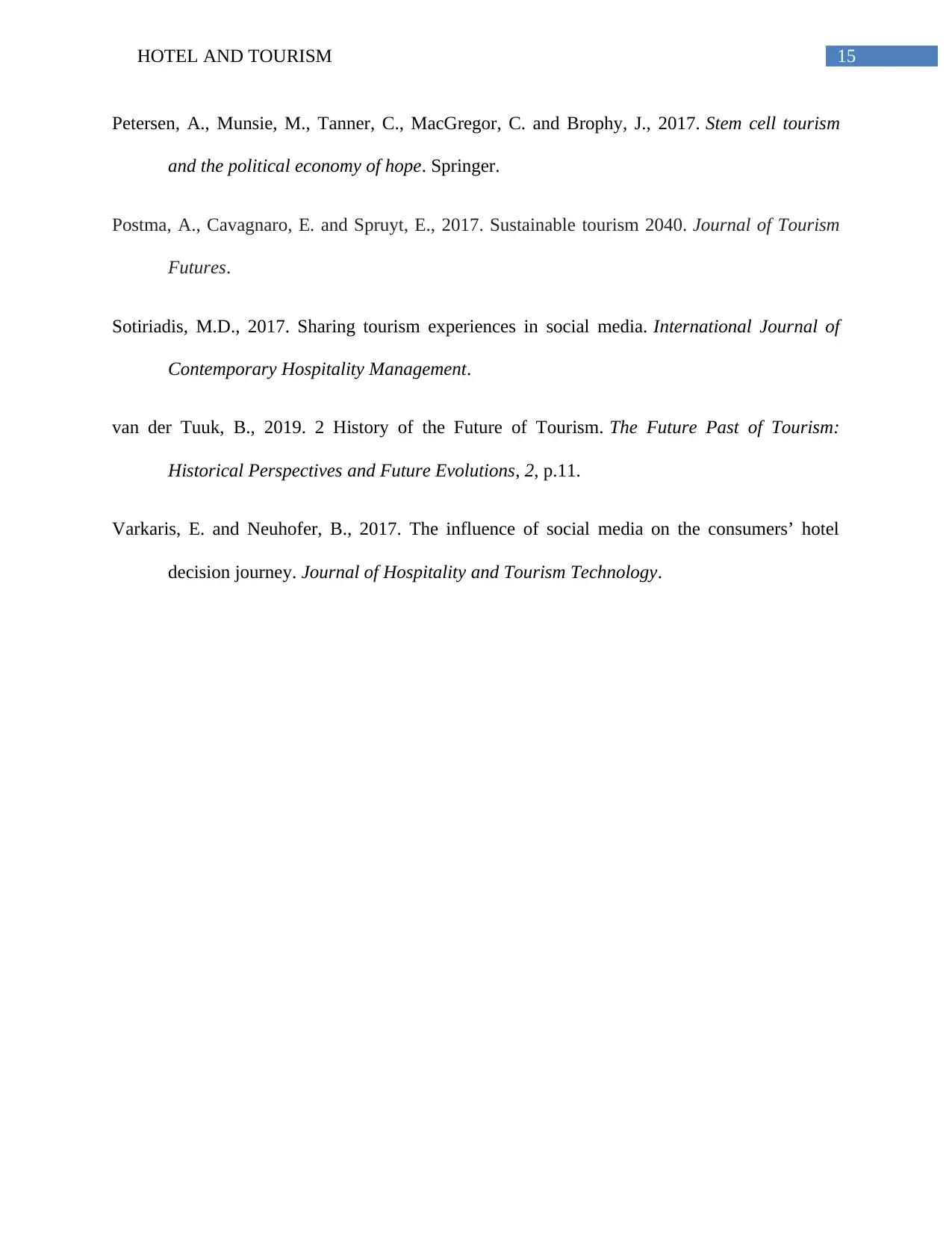
15HOTEL AND TOURISM
Petersen, A., Munsie, M., Tanner, C., MacGregor, C. and Brophy, J., 2017. Stem cell tourism
and the political economy of hope. Springer.
Postma, A., Cavagnaro, E. and Spruyt, E., 2017. Sustainable tourism 2040. Journal of Tourism
Futures.
Sotiriadis, M.D., 2017. Sharing tourism experiences in social media. International Journal of
Contemporary Hospitality Management.
van der Tuuk, B., 2019. 2 History of the Future of Tourism. The Future Past of Tourism:
Historical Perspectives and Future Evolutions, 2, p.11.
Varkaris, E. and Neuhofer, B., 2017. The influence of social media on the consumers’ hotel
decision journey. Journal of Hospitality and Tourism Technology.
Petersen, A., Munsie, M., Tanner, C., MacGregor, C. and Brophy, J., 2017. Stem cell tourism
and the political economy of hope. Springer.
Postma, A., Cavagnaro, E. and Spruyt, E., 2017. Sustainable tourism 2040. Journal of Tourism
Futures.
Sotiriadis, M.D., 2017. Sharing tourism experiences in social media. International Journal of
Contemporary Hospitality Management.
van der Tuuk, B., 2019. 2 History of the Future of Tourism. The Future Past of Tourism:
Historical Perspectives and Future Evolutions, 2, p.11.
Varkaris, E. and Neuhofer, B., 2017. The influence of social media on the consumers’ hotel
decision journey. Journal of Hospitality and Tourism Technology.
1 out of 16
Related Documents
Your All-in-One AI-Powered Toolkit for Academic Success.
+13062052269
info@desklib.com
Available 24*7 on WhatsApp / Email
![[object Object]](/_next/static/media/star-bottom.7253800d.svg)
Unlock your academic potential
© 2024 | Zucol Services PVT LTD | All rights reserved.





